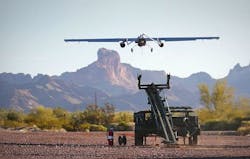IMSAR chosen to develop small radar systems for small unmanned aerial systems
Officials of the Army Contracting Command at Natick, Mass., announced a $99 million contract to IMSAR for research and development, rapid advancement, and integration of small-aperture radars on small unmanned aerial systems (UAS).
IMSAR specializes in small radar systems, digital signal processing, radar, manufacturing, and inertial measurement systems. The Army Contracting Command-Natick supports the Army's Natick Soldier System Center (NSSC), which develops technologies for combat effectiveness and survivability for U.S. soldiers.
IMSAR builds the NanoSAR B and NanoSAR C small radar systems. The NanoSAR B provides high-quality radar imagery by working together with a tactical inertial navigation system and digital data link with throughput of 6.5 megabits per second.
The NanoSAR B measures 6.2 by 7.2 by 4.5 inches, weighs 3.5 pounds, and transmits 1 Watt of power. On board firmware compresses real-time SAR data and transmits it to a ground station that generates and archives the imagery, The system operates day or night, in rain, snow, fog, dust, or smoke.
The IMSAR NanoSAR C is designed for cost-effective detection, location, and classification of targets. The unit measures 5.5 by 3.5 by 2 inches, weighs 2.6 pounds, and transmits 1 Watt of power. NanoSAR C provides detailed real-time aerial radar images from a payload small and light enough to be mounted in a Tier I or II UAS.
NanoSAR C is integrated with IMSAR’s Lisa ground station and Viper communication link, and operates day or night, in rain, snow, fog, dust, or smoke. IMSAR officials claim the NanoSAR C is the world’s smallest SAR.
Its radar, turret, antenna, and cabling total less than 86 cubic inches, and can mount in a 7-inch-diameter wing-mounted pod, or inside the aircraft fuselage.
Related: RDRTec to develop sense-and-avoid radar for Fire Scout and Triton unmanned aircraft
Synthetic aperture radar, or SAR, uses the relative motion between its aircraft platform and the target provide long-term coherent-signal variations that yield fine spatial resolution.
SAR repeatedly illuminates target areas with radar pulses at wavelengths anywhere from a meter down to millimeters, IMSAR officials say. The system coherently detects and stores the radar returns at the different antenna positions and post-processes them together to resolve image elements.
SAR images are useful for remote sensing and mapping the Earth's surface, and can be implemented as inverse SAR by observing a moving target over a substantial time with a stationary antenna, company officials explain.
On this contract IMSAR will do the work in locations based on the needs of each order, and should be finished by August 2019. For more information contact IMSAR online at www.imsar.com, or the Army Contracting Command-Natick at www3.natick.army.mil.
About the Author
John Keller
Editor-in-Chief
John Keller is the Editor-in-Chief, Military & Aerospace Electronics Magazine--provides extensive coverage and analysis of enabling electronics and optoelectronic technologies in military, space and commercial aviation applications. John has been a member of the Military & Aerospace Electronics staff since 1989 and chief editor since 1995.
